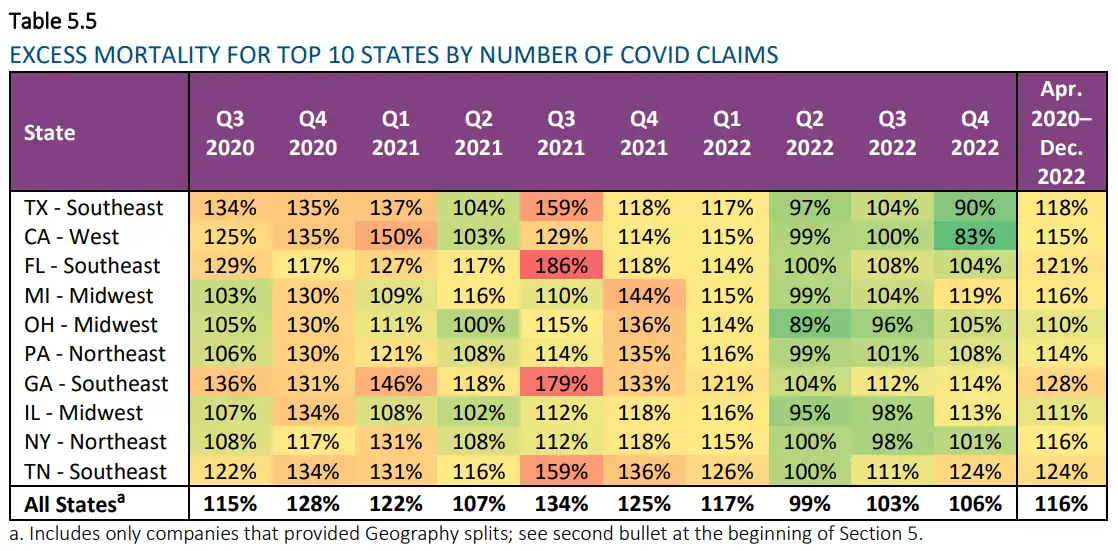Without a thorough and collaborative exploration, we can’t know what’s killing us – or how to stop it.
Life insurance actuaries are reporting that many more people are dying – still – than in the years before the pandemic. And while deaths during COVID-19 had largely occurred among the old and infirm, this new wave is hitting prime-of-life people hard.
No one knows precisely what is driving the phenomenon, but there is an inexplicable lack of urgency to find out. A concerted investigation is in order.
Deaths among young Americans documented in employee life insurance claims should alone set off alarms. Among working people 35 to 44 years old, a stunning 34% more died than expected in the last quarter of 2022, with above-average rates in other working-age groups, too.
“COVID-19 claims do not fully explain the increase,” a Society of Actuaries report says.

Among working people ages 35-44, 34% more died than expected in the last quarter of 2022, with above-average rates in other working-age groups, too, according to a Society of Actuaries Research Institute report.
 group-life-covid-19-mortality-12-2022
group-life-covid-19-mortality-12-2022
From 2020 through 2022, there were more excess deaths proportionally among white-collar than blue-collar workers: 19% versus 14% above normal. The disparity nearly doubled among top-echelon workers in the fourth quarter of 2022, U.S. actuaries reported.
And there was an extreme and sudden increase in worker mortality in the fall of 2021 even as the nation saw a precipitous drop in COVID-19 deaths from a previous wave. In the third quarter of 2021, deaths among workers ages 35-44 reached a pandemic peak of 101% above – or double – the three-year pre-COVID baseline. In two other prime working-age groups, mortality was 79% above expected.
Excess deaths are a global phenomenon
This isn’t only happening in the United States. The United Kingdom also saw “more excess deaths in the second half of 2022 than in the second half of any year since 2010,” according to the Institute and Faculty of Actuaries.
In the first quarter of 2023, deaths among people 20 to 44 years old were akin to “the same period in 2021, the worst pandemic year for that age group,” U.K. actuaries reported. Younger-age death rates were “particularly high” when compared with the average mortality for 2013 to 2020.
Oppenheimer’s nuclear fallout:How his atomic legacy destroyed my world
In Australia, 12% more people died than expected in 2022, according to that nation’s Actuaries Institute. A third of the excess was non-COVID deaths, a figure the institute called “extraordinarily high.”
Death rates are lower, of course, than in 2020 and 2021. But they are far from normal.
In the year ending April 30, 2023 – 14 months after the last of several pandemic waves in the United States – at least 104,000 more Americans died than expected, according to Our World in Data. In the U.K., 52,427 excess deaths were reported in that period; in Germany, 81,028; France, 17,731; Netherlands, 10,418; and Ireland, 2,640.
What explains this wave of excess deaths?
Week in, week out, this unnatural loss of life is on the scale of a war or terrorist event.
The actuarial reports can only speculate on the factors causing these deaths, including oft-cited delayed health care, drug overdoses and even weather patterns. But the question remains: What explains this ongoing wave of excess deaths?
Life insurance data suggests something happened in the fall of 2021 in workplaces, especially among white-collar workers. These are people whose education, income level and access to health care would predict better outcomes.

The executive of a large Indiana life insurance company was clearly troubled by what he said was a 40% increase in the third quarter of 2021 in those ages 18-64.
“We are seeing, right now, the highest death rates we have seen in the history of this business – not just at OneAmerica,” CEO Scott Davison said during an online news conference in January 2022. “The data is consistent across every player in that business.”
Governments and regulatory agencies should cooperate with life insurers to investigate this trend at the national and multinational level.
Without a thorough and collaborative exploration, we can’t know what’s killing us – or how to stop it.
Dr. Pierre Kory, M.D., is president and chief medical officer of the Front Line COVID-19 Critical Care Alliance. Mary Beth Pfeiffer is an investigative reporter and author of two books.
